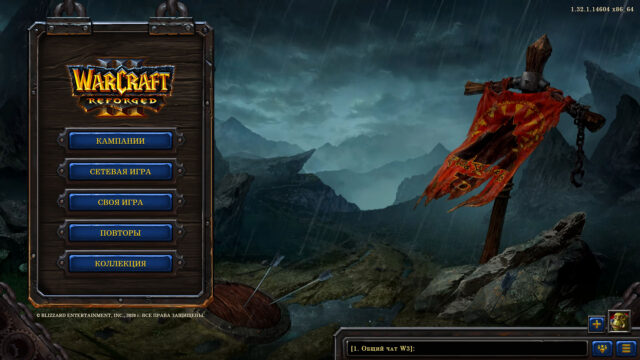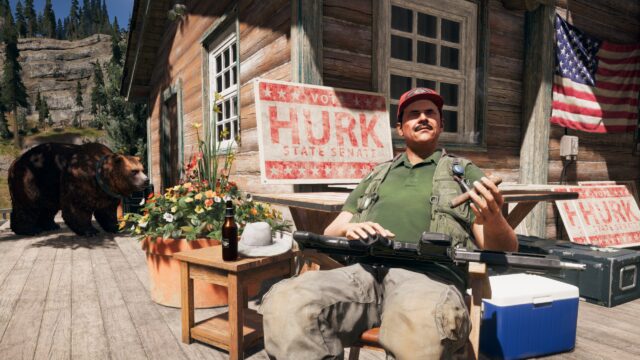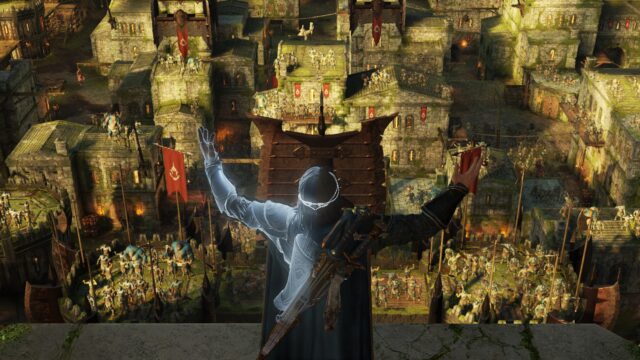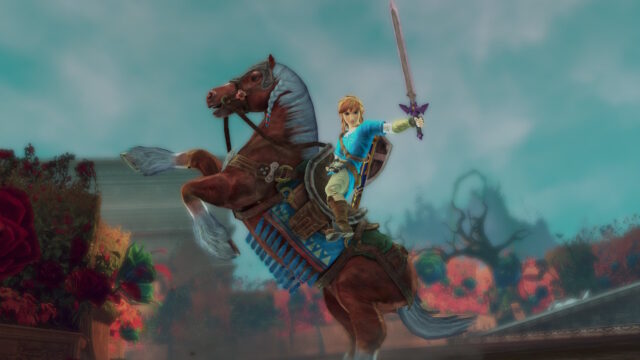Black Book Review: Cards, Book, Witchcraft
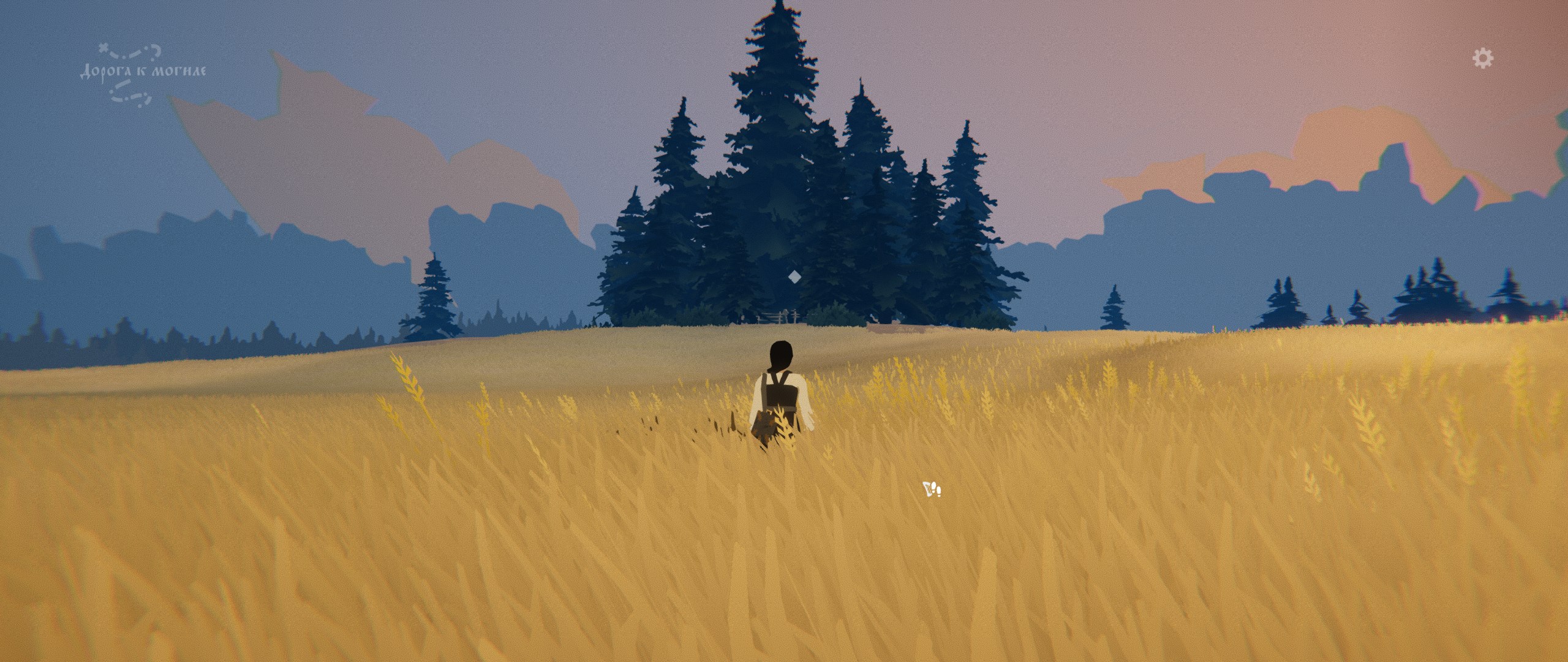
Slavic mythology is not often encountered in video games. Unlike many other myths and legends. Strange, isn’t it?
We remember that Zeus did not get along with Hero and gave birth to Athena himself from his head, we know who kitsune and bakeneko are, we can easily tell you where and from where Odin spilled the mead of poetry while flying to Asgard. But why do we know so little about our own past? Okay, mythology is one thing, okay – kikimoras, leshaks, and banniks, but who can immediately answer what “seni” and “ovin” mean? (No, not “hay” and “ram”.) What are “polati” and “matica”? What is “rosstan”? Yes, outdated words, but they were not so outdated a hundred years ago.
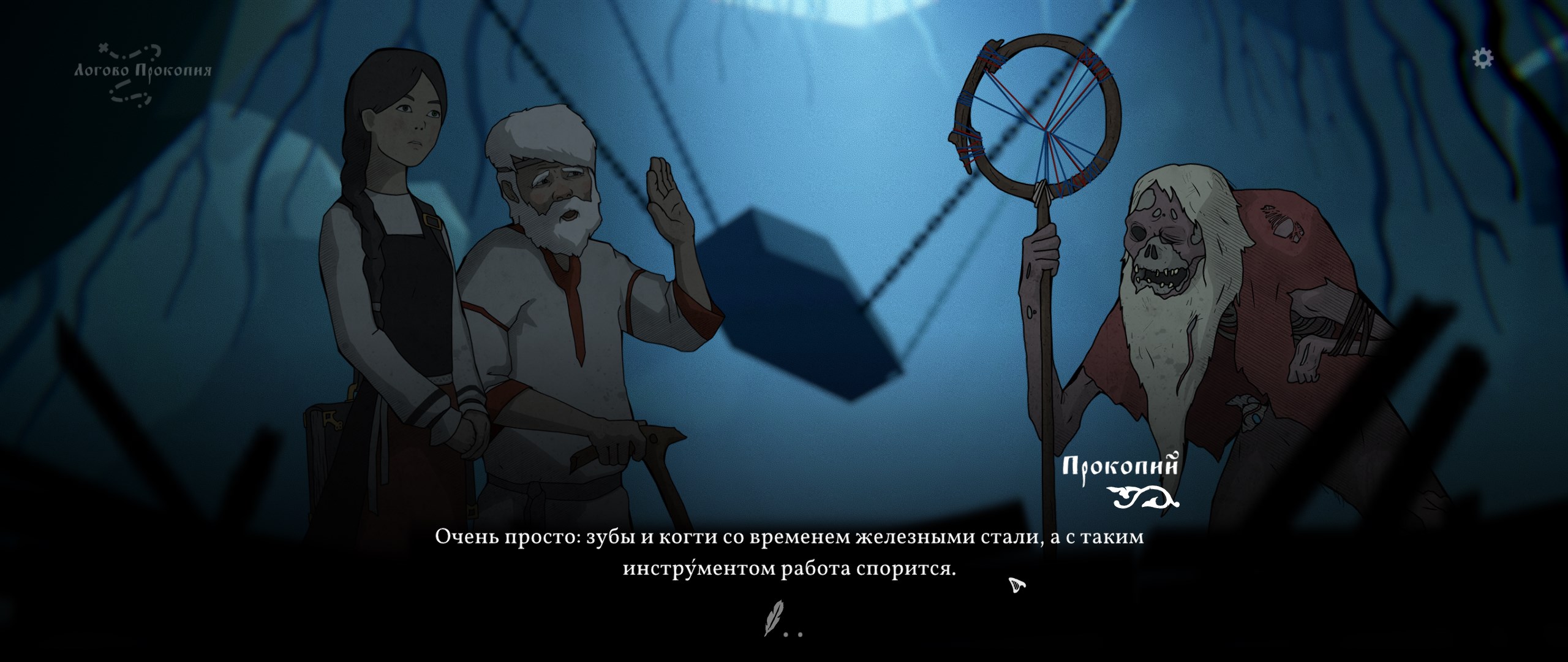
The game Black Book by Morteshka Studio. (The creators of Mooseman) successfully fill this gap. And not in the form of a boring encyclopedia, but in the form of an exciting and creepy RPG. The action takes place – suddenly! – in the Perm Governorate, in 1879. Dark, cold times. The northern backwoods of the country, where for peasants and Cherdyn is a huge city, and just thinking about Perm itself is scary. The first act – it has begun!
Too many male stories start with “and so the hero set off in search of adventures.” Too many female stories start with “once upon a time there was a girl, and it was her own fault.” Especially in Russia, and even at the end of the nineteenth century. Vasilisa grew up as an orphan, under the care of her only relative, her grandfather Egor, who lived in a remote village. Egor offered her to become a “knowledgeable one,” a witch. Vasilisa refused because she fell in love and wanted to get married.

But when her fiancé hanged himself without any explanation and was buried outside the church fence (as is customary for suicides), Vasilisa decided – enough! As they say, to Hell with this! In the literal sense: she has to undergo initiation as a witch, descend into Hell, and take hold of the Black Book that used to belong to her teacher, Yegor. According to legend, if a “knowledgeable” person can open all seven seals that lock the Book, then the artifact will grant their most cherished wish. Of course, Vasilisa’s cherished wish is to bring back her beloved. The rest is secondary.
(Who was that in the back row who mentioned that playing with unlicensed necromancy is not a good idea? Don’t stand in the way of an angry woman!)
The plot is divided into chapters, corresponding to the seals on the Book. The seals are very diverse: water, aspen, wolf… Opening them will also require some unconventional methods. But no worries: Yegor’s mentor will give some advice, and other helpers will be found along the way! The stories are truly captivating, and each one tells about a completely new evil, about witches, local superstitions, and omens. Vasilisa will have to organize someone else’s wedding, run through the forests after werewolves, befriend a talking skull, visit the chambers of the water spirit – and still have a million other things to do!

Black Book is a mix of a visual novel and a card game. The cards represent pages from the very same Book, so at first, while only one seal is broken, Vasilisa has access to only basic “spells”. The number of spells we can cast in one turn is also limited.
The card-based combat part of the game is excellent. We start with the simplest cards – a few attacking and a few defensive ones. Gradually, as we break the seals on the Book, we unlock complex and multi-level cards that can be used to create various combos. Closer to the middle and especially the end of the game, the player is able to customize a narrow-focused deck to their needs (for example, I found it most convenient to use a fast-black debuffing set of cards based on Corruption). There are cards that “burn” upon use, and there are cards that remain in a spell-conspiracy for several turns, enhancing it.
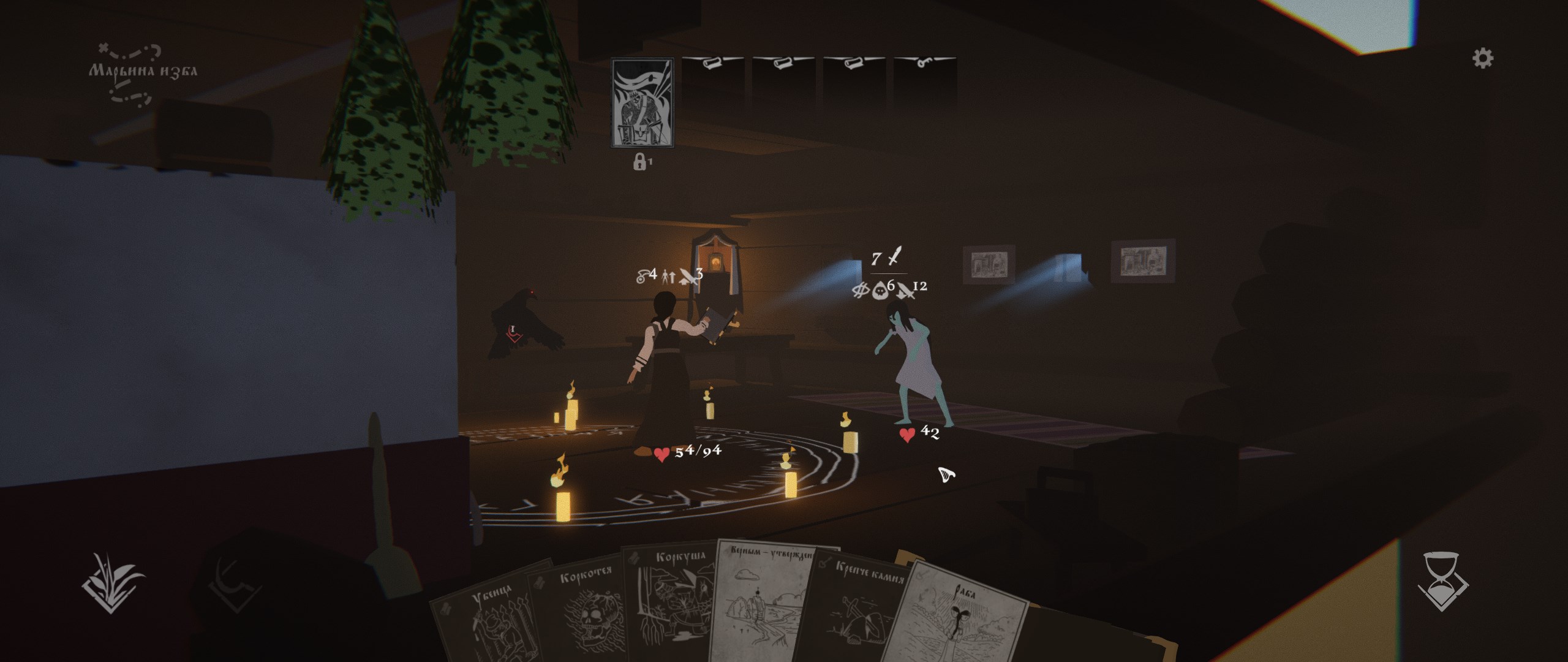
Our sorceress is not a witcher with a heavy sword, she doesn’t know how to wear armor, so she can only use light “amulets” (up to six, used as an equivalent of armor) and various useful herbs (used in battle as an instant item).
The combat itself looks three-dimensional and… well, maybe not spectacular, but convenient. Vasilisa and her allies are on the left, enemies on the right, “cards in hand” are at the bottom, and “cards in the conspiracy” are at the top. Defeated creatures contort or disintegrate in a picturesque manner. However, sometimes it would be nice if the screen was brighter: it’s difficult to make out some battles with a crowd of demons in the darkness, what kind of black imps are there in a black room! But there’s nothing to be done: Vasilisa has to deal with witchcraft at night. And decent lighting along the roads or at least pocket flashlights haven’t been invented yet.
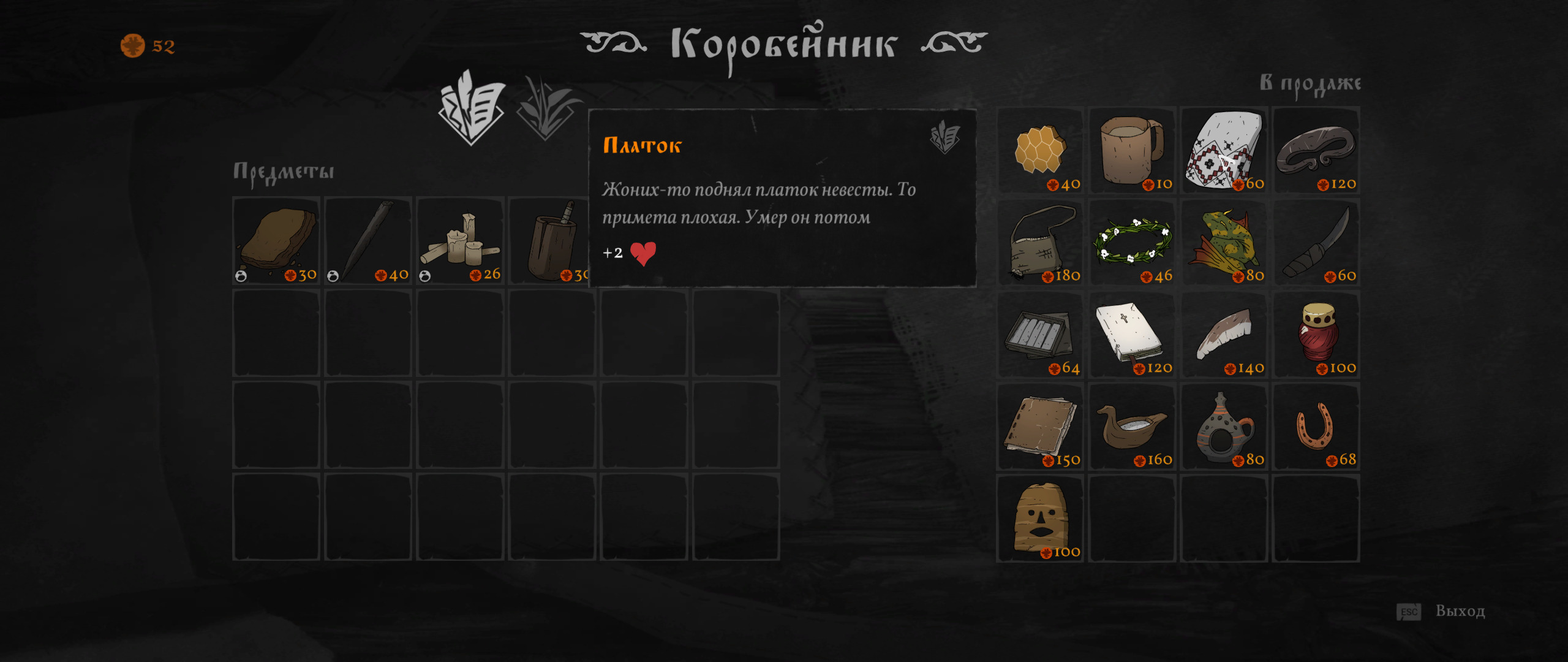
But there is also a small downside: the engine, which displays the tactical battles quite well, is completely unsuitable for three-dimensional locations. In the game, there are occasional moments where we control Vasilisa in small areas of the terrain and explore the surroundings for key points. This, without exaggeration, is terrible. The heroine stumbles upon invisible barriers, the camera follows her with the grace of a lame kikimora, the flat trees and flowers that look so beautiful on static screens shamelessly stand out… It would be better if these stages were removed altogether. Or if they were made in any other engine, even RPG Maker.
The rest of the “action” takes place in the format of a visual novel: every day (or rather, evening – let’s not forget about the witchcraft business, right?) the heroine meets in her hut or at some campsite, where she can chat with her companions, play cards, manage inventory, and talk to the petitioners. The petitioners are those who need something from the witch, and there are usually plenty of them: no wonder, it’s the end of the nineteenth century, the middle of nowhere, you can’t find doctors from the capital, let alone witchers from Rivia, and there are enough reasons to worry. A child may fall ill with a fever, an old man may get lost in the forest, or strange sounds and creaks may be heard at night – it’s scary!

And then we set off on our journey and the most interesting part begins – playing detective! No, card battles are also wonderful and a lot of fun, but I liked the little investigations and puzzles the most in the game. In the dialogues or in the encyclopedia entries before the task, we are given hints, so we don’t have to randomly guess – we just have to think and read carefully.
(Just before playing Black Book, I played Ace Attorney Chronicles – the cultural contrast was particularly striking. In England at the end of the nineteenth century, there was steampunk, airships, steam engines – while in the Perm Governorate, there were herbalists, demons, and superstitions, and it’s good if one priest in the whole village understands literacy. But the detective part… it suddenly turned out to be similar!)
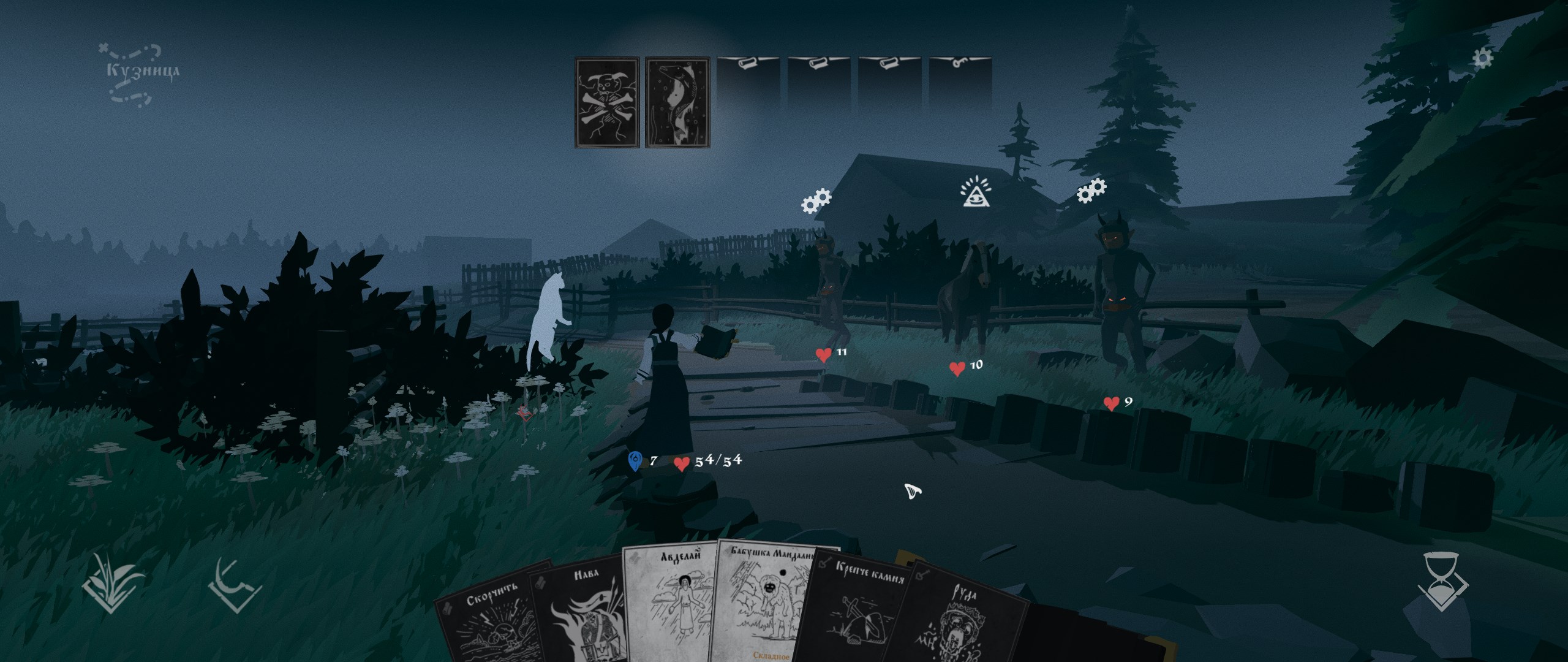
How to expose a changeling baby? (No, not an elven one). How to find a way out if you got lost in the thicket and suspect that the “master” is leading you? What kind of monster is a “skinflint”? How is a “neighbor” different from a neighbor? Who pulls the yarn in the hut at night – a kikimora, a shishiga, or a domovoy? How to drive away a mermaid from the well? These are the everyday questions for a witch from Cherdyn.
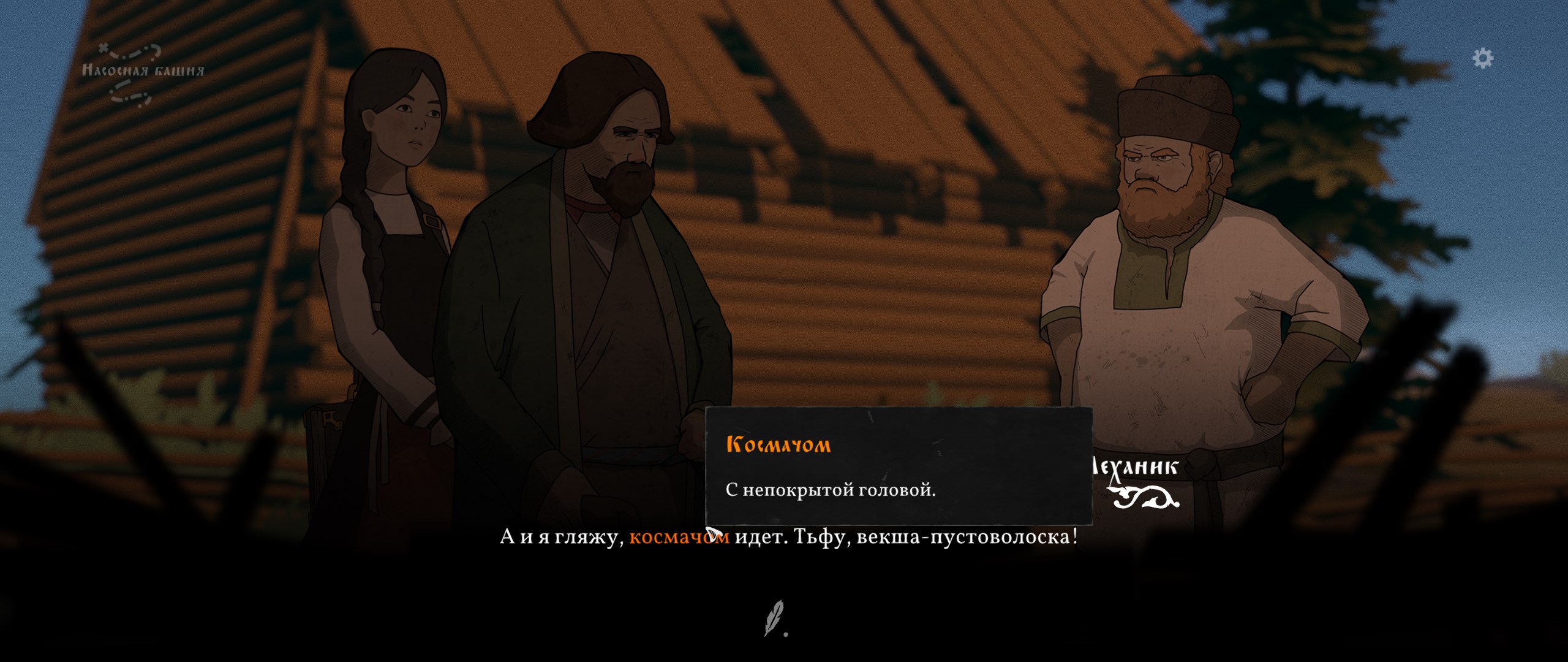
And the episode “recognizing the forest spirit in human form among many suspects” with the search for evidence and questioning witnesses – it’s absolutely brilliant, Phoenix Wright would approve.
Black Book is not just fantasy. In the developers’ previous game, Mooseman (“Man-Bear”), there was a lot of Komi-Permyak mythology. In “Black Book,” there is so much information about the beliefs of the peasants of the Perm Governorate in the nineteenth century that the game can confidently be considered educational.
You probably know it yourself: Christianity, which came to these lands in the late 9th century, where idols and spirits of the elements were worshipped, changed, adapted, and after several centuries no longer resembled the “original.” Pagan holidays intricately mixed with church ones. Sacrifices made to minor gods were redirected to forest spirits and water spirits. Lower spirits that harmed people became “bisy” and “chortyaki.” Icons of saints that didn’t fulfill requests were punished with whips as “unworthy.” Food was still left on graves – and it still is today!
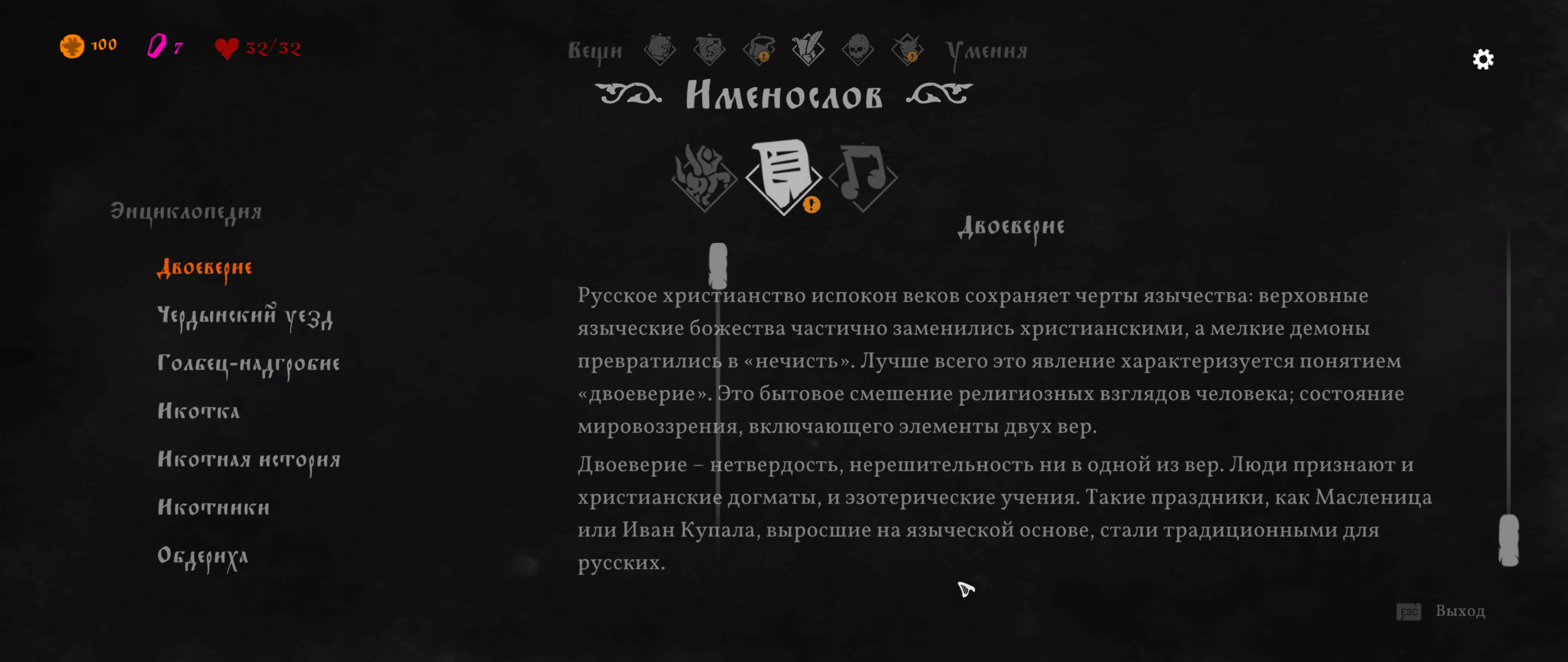
The final faith turned out to be very strange. According to the beliefs of most peasants, heaven was somewhere there, unclear where, and angels were not visible – but hell, there it is, and demons, there they are, wandering everywhere! It is not surprising that everyone needed sorcerers, witches, and “experts” who could somehow understand the chaos that was happening. But, as is customary when dealing with supernatural forces, ordinary logic is not applicable here. You can only trust your intuition and the logic of others’ unclear, otherworldly rules of behavior gleaned from old stories.
One of these rules is quite amusing (and we read about it in Gogol’s works): the unclean spirits love to play cards! And why not, who doesn’t love it. The main game, whether for humans or devils in the countryside, is “fool”, simple but addictive. Often, by suggesting playing cards, you can avoid a confrontation or even earn some money.
Keep in mind that the supernatural scoundrels know how to cheat, substituting regular cards with trump cards… well, our Vasilisa is no exception: over time, you can improve skills that allow you to do the same, as well as find items that help in cheating.

The music adds a considerable amount of atmosphere to the game. It is long, melancholic, and contemplative – as if you are truly wandering along a dusty road on a summer evening, with the dark treetops closing in above your head. A wonderful addition is the folk songs performed by the student choir of the Perm Regional College of Arts and Culture. I never considered myself a fan of the genre, but listening to “Oi, kumushki” or “Sidel voron” while looking at the bright clouds racing across the dark sky and the roofs of village houses in the twilight turned out to be unexpectedly great. (Yes, the backgrounds in the game are also magnificent.) The characters are fully voiced, and the local accent is not forgotten either.
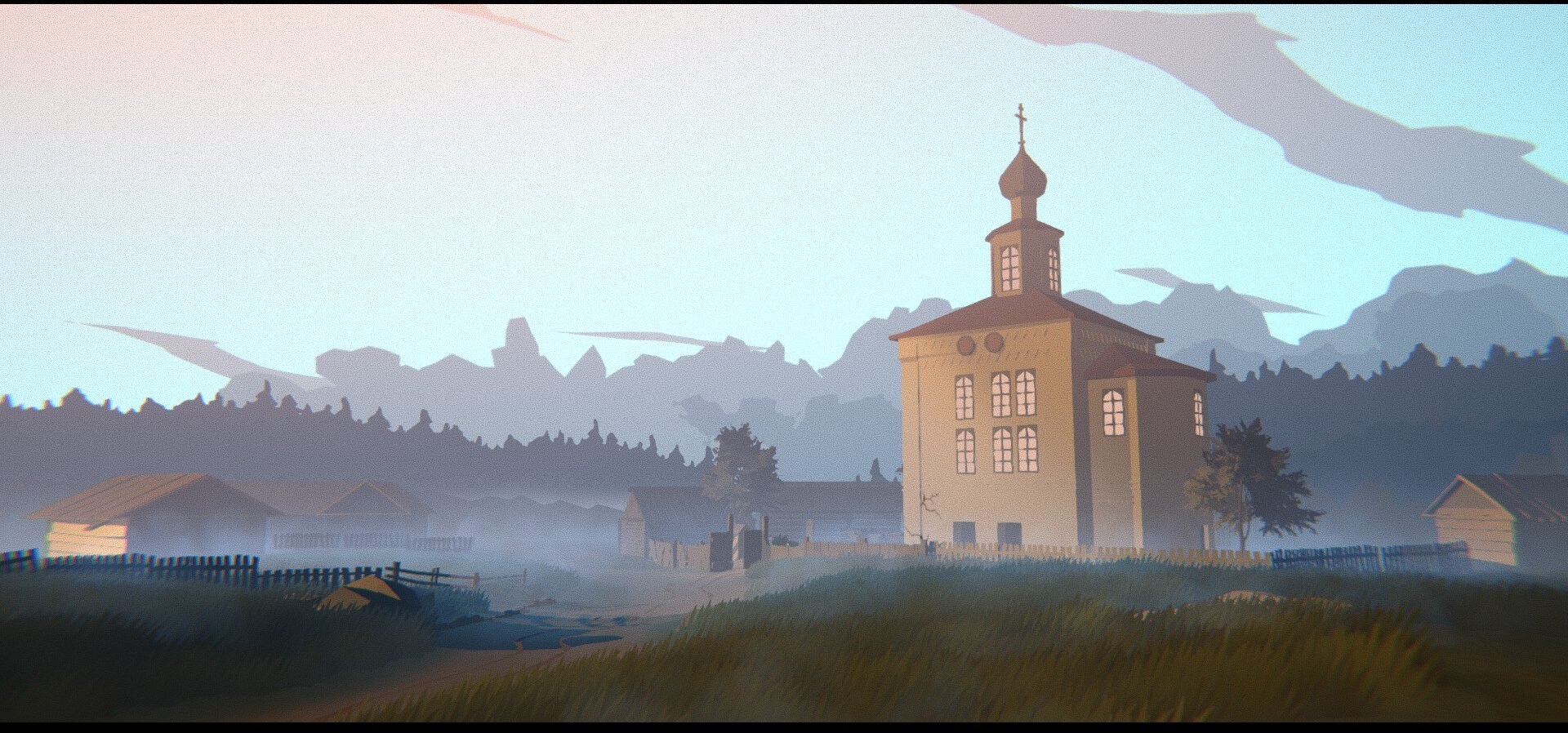
There are several endings in Black Book, as befits a decent RPG. I won’t spoil which ones. You’ll figure it out for yourself. I’ll just say that the choices made during the game have a fascinating impact on the final chapter.
In any case, you finish the game with a wealth of authentic words, captivating tales, and little-known facts. The developers managed to combine a good RPG with a full-fledged excursion into the nineteenth century. It’s a challenging task, and they executed it to the fullest extent!
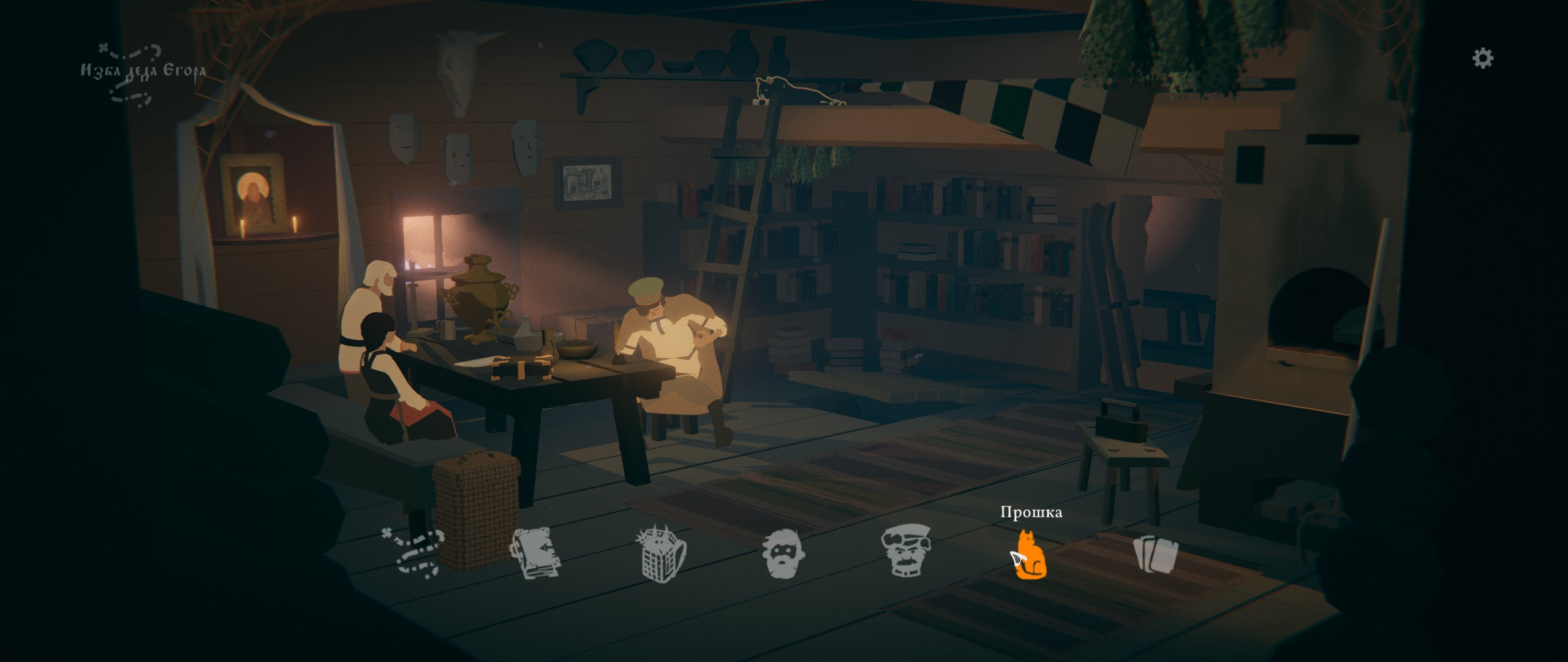
I won’t say that the game is perfect; no. I didn’t like, for example, the puzzle battles where you have to win the battle with a predetermined deck in the only possible way (according to the Steam forums, not many people liked them at all); I prefer freedom of action. The graphics in the 3D locations, as mentioned above, leave something to be desired. But, honestly, these are minor things. The game definitely deserves your attention.
Share
Discuss
More Reviews


